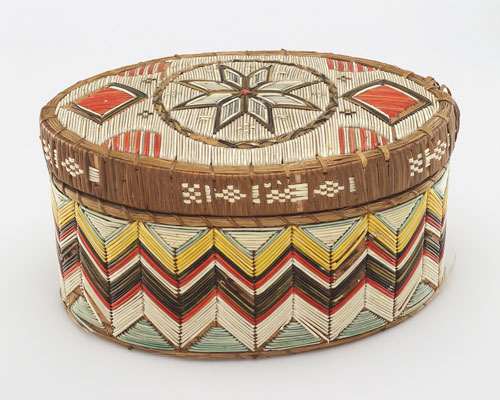Long before trade beads became widely available, quillwork emerged as a significant decoration among Indigenous cultures. This time-honored craft predating European colonization of North America involves using porcupine quills to create elaborate designs on clothing and practical items. First noted in Alberta, Canada, in the 6th century through Cheyenne oral traditions, this art form spans numerous tribes. Examples of quillwork include “decorated moccasins, cradleboards, rosettes for men’s garments and tipis, as well as hide robes and backrests” (Crazy Crow Trading Post 3). The complexity and skill in quillwork make it a powerful means of expressing cultural, spiritual, and social identities.
The method of collecting porcupine quills is often misunderstood. Contrary to the belief that porcupines can shoot their quills, these are loosely attached and can be easily collected. Indigenous collectors would place a blanket over the porcupine, causing the quills to adhere to the fabric. Once the blanket was removed, the quills were sorted by quality. Most quills are approximately two and a half inches long and one-sixteenth of an inch wide, with finer quills found near the porcupine’s head, reserved for delicate designs.
After collection, quills must be cleaned and dried to remove natural oils and fats that hinder the dyeing process. Traditional dyes, sourced from local plants and substances, include bloodroot and cochineal for red, indigo or robin’s eggs for blue, lichen for yellow, and algae for green.
The creation of quillwork involves specialized tools. A small rounded knife helps trim excess quill ends, while a quill flattener—originally made from bone or horn but now often crafted from metal—presses the quills flat to ensure smooth and even designs. Some artisans prefer to flatten quills by hand, using their nails or teeth, instead of a flattener.
Recently, there has been a resurgence of interest in traditional quillwork within Indigenous communities. Organizations like the Tomaquag Museum are committed to preserving this art form and supporting Indigenous artists. Despite these efforts, quill workers face challenges such as limited resources and the need for greater appreciation of their craft. However, the importance of maintaining the practice of quillwork cannot be overstated. It is crucial for preserving cultural heritage and providing a deep understanding of Indigenous traditions and lifestyles, enlightening us about the rich and diverse cultures of Indigenous communities.
Works Cited
Crazy Crow Trading Post. “Native American Indian Porcupine Quillwork, How to Do Porky Quillwork.” Crazy Crow Trading Post, 28 Sept. 2015, www.crazycrow.com/site/quillwork/.
Holy Blue Legs, Alice New . “Alice New Holy Blue Legs.” Www.arts.gov, www.arts.gov/honors/heritage/alice-new-holy-blue-legs#:~:text=Quillwork%20was%20extremely%20complex%2C%20requiring. Accessed 20 July 2024.
Pegler, James. “These Cheyenne Women Carried Their People with Quillwork.” OutwardOn.com, 2 Aug. 2017, outwardon.com/article/cheyenne-quillwork/.
Prindle, Tara. “NativeTech: Natural Dyes for Porcupine Quills.” Www.nativetech.org, www.nativetech.org/quill/dyes.html#:~:text=The%20orange%20and%20red%20quills. Accessed 20 July 2024.
Skab. “Collecting, Washing and Dying Quills.” Bushcraft USA Forums, 21 July 2013, bushcraftusa.com/forum/threads/collecting-washing-and-dying-quills.97638/. Accessed 20 July 2024.
United States Department of Agriculture. “Dyes.” Www.fs.usda.gov, www.fs.usda.gov/wildflowers/ethnobotany/dyes.shtml#:~:text=Bloodroot%20(Sanguinaria%20canadensis)%20was%20used.














